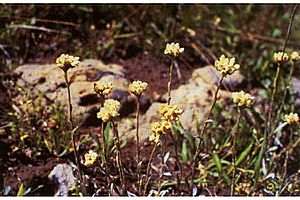Flat-top pussytoes facts for kids
Quick facts for kids Flat-top pussytoes |
|
|---|---|
 |
|
| Scientific classification | |
| Genus: |
Antennaria
|
| Species: |
corymbosa
|
| Synonyms | |
|
|
Antennaria corymbosa is a type of flowering plant from North America. People often call it flat-top pussytoes or meadow pussytoes. It's part of the daisy family, just like sunflowers! You can find this plant growing in western Canada (like British Columbia and Alberta) and the western United States. It likes cool, wet places such as mountain meadows and riverbanks. You'll mostly see it in big mountain ranges like the Rocky Mountains, the Cascades, and the Sierra Nevada.
What is Flat-top Pussytoes?
Antennaria corymbosa is a small plant that lives for many years. It grows from a group of thin, gray, fuzzy leaves that look a bit like tiny spoons. These leaves are usually only one or two centimeters long.
How it Grows
This plant sends up several straight stems. These stems are not very tall, usually less than 15 centimeters (about 6 inches). Each stem has a cluster of several small flower heads at the top.
Male and Female Plants
Antennaria corymbosa is a special kind of plant because it has separate male and female plants. This means one plant will have only male flowers, and another plant will have only female flowers. Even though they are different, the flower heads generally look quite similar.
Flowers and Seeds
Each flower head has a surface made of white, papery parts called phyllaries. These parts often have tiny dark dots on them. Inside, there are many tiny individual flowers. After the female flowers are pollinated, they produce small fruits called achenes. These achenes are less than a millimeter long. They also have a soft, fluffy top called a pappus, which helps the seeds float away in the wind.

